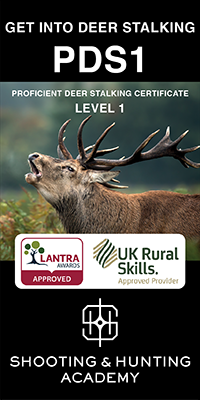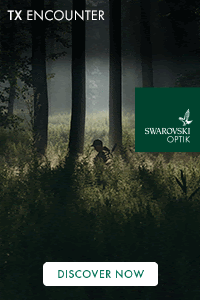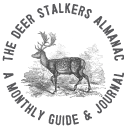
What to expect from your Deer Stalking month by month. Enter your email address below to receive the Almanac:
6.5x55mm Swedish
The 6.5x55 Swedish Mauser or simply 6.5 Swedish as it is often referred, although relatively new amongst UK deer stalkers is not in fact a new calibre. Having been introduced initially as a military calibre over 100 years ago it was soon adopted by Scandinavian hunters who found it enough of a calibre for use on animals as large as Moose and even Polar Bear!
There is no denying it is a deceptively effective calibre however on initial impressions it is easy at first to be confused. The figures surrounding this .264 calibre put simply, appear rather unimpressive. A 140 grain bullet is launched at around 2650fps and the energy at the muzzle is little more than that of a .243 Winchester at around 2050ft lbs.
The trajectory is also far from impressive dropping around 4.6 inches at 200yards with a 100yrd zero and 16inches at 300yards.
However this calibre is somewhat of an enigma and for many is the perfect trade off between shootability and knock down power. Amongst other reasons this is because it produces a minimum of recoil and muzzle blast yet it is able to knock down animals that on paper just don't look justifiable.
Added to this, the long thin bullet which has excellent penetration and great accuracy and the fact it is able to handle bullet weights from 77 grains to 160 grains and things start to make sense again.
With the size of our UK deer and the ranges at which we shoot for me this calibre is simply perfect for UK deer stalking, its is therefore perhaps no surprise that UK deer stalkers are adopting this calibre more and more.
6.5x55mm Swedish
The 6.5x55 Swedish Mauser or simply 6.5 Swedish as it is often referred, although relatively new amongst UK deer stalkers is not in fact a new calibre. Having been introduced initially as a military calibre over 100 years ago it was soon adopted by Scandinavian hunters who found it enough of a calibre for use on animals as large as Moose and even Polar Bear!
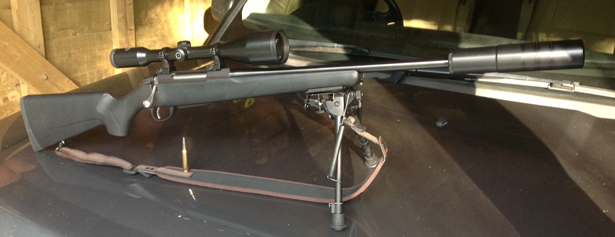
(Above: A great combination for UK stalking, a Tikka T3 chambered in 6.5x55)
There is no denying it is a deceptively effective calibre, however on initial impressions it is easy at first to be confused. The figures surrounding this .264 calibre put simply, appear rather unimpressive. A 140 grain bullet is launched at around 2650fps and the energy at the muzzle is little more than that of a .243 Winchester at around 2050ft lbs.
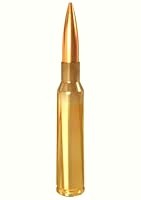 The trajectory is also far from impressive, dropping around 4.6 inches at 200yards with a 100yrd zero and 16inches at 300yards.
The trajectory is also far from impressive, dropping around 4.6 inches at 200yards with a 100yrd zero and 16inches at 300yards.
(Left: A great choice of calibre - the 6.5x55 Swedish)
However this calibre is somewhat of an enigma and for many is the perfect trade off between shootability and knock down power. Amongst other reasons this is because it produces a minimum of recoil and muzzle blast, yet it is able to knock down animals that on paper just don't look justifiable.
Added to this, the long thin bullet which has excellent penetration, great accuracy and the fact it is able to handle bullet weights from 77 grains to 160 grains and things start to make sense again.
With the size of deer in the UK, and the ranges at which we shoot them, for me this calibre is simply perfect for lowland deer stalking.
It is also worth mentioning that with the often stringent conditions being placed on the Firearm Certificates of new comers to the sport, another reason for the huge up take of this calibre stems from the fact that many Firearms Enquiry Officers consider this calibre to be an acceptable calibre with which to start, and a good platform from which to gain experience before progressing onto larger calibre rifles.
With all things considered and irrespective of whether this is your first calibre or one of many, it is perhaps no surprise that UK deer stalkers are adopting the 6.5x55 calibre in greater and greater numbers.
Typical Ballistics: (140 grain Bullet)
Muzzle Energy: 2050 ft/lbs
Muzzle Velocity: 2650 fps
Back to Overview
.25-06 Remington
The 25-06 Remington was originally a wild cat calibre until standardised by Remington in 1969.
 (Left: The .25-06 is an unusual choice, but none the less a great option for stalking in the highlands where longer shots are often required)
(Left: The .25-06 is an unusual choice, but none the less a great option for stalking in the highlands where longer shots are often required)
This cartridge is basically a flat shooting necked down 30-06 Springfield, which can be used with bullet weights ranging from 90 - 120 grains. 120 grain bullets produce around 2990 fps and 2380 ftlbs of energy at the muzzle.
Although having less of a kick than a .270 or .30.06, I found the recoil to be a little snappy. That said it has an excellent ballistic coefficeint and is therefore very flat shooting and able to produce plenty of down range punch.
Due to the flat trajectory, this is a great calibre for use in the highlands, or for use on light skinned plains game. That said it is little seen amongst UK deer stalkers, who, if hunting at longer ranges, seem to prefer the .270 or .308 Winchester.
Perhaps as a result of the UK's deer stalkers being reluctant to adopt this calibre, ammunition is not easily found, and when it is located, can be a little on the pricey side.
Typical ballistics (120 grain bullet)
Muzzle Energy: 2380 ft/lbs
Muzzle Velocity: 2990 fps
Back to Overview
6mm PPC
The 6mm PPC or 6 PPC as it is more commonly refered to is in fact a widcat calibre produced from a necked up .22 PPC which in turn originated from the .220 Russian. The 6mm bullet is of course also the same diameter as the .243.
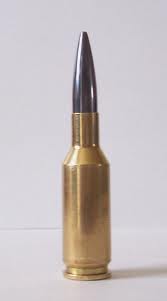 Developed predominantly for use in Bench Rest shooting out to 300 yards it is an extremely accurate calibre perhaps due to the very uniform velocity produced from short cartridges that are very efficient combustion chambers.
Developed predominantly for use in Bench Rest shooting out to 300 yards it is an extremely accurate calibre perhaps due to the very uniform velocity produced from short cartridges that are very efficient combustion chambers.
(Left: The 6mm PPC)
The 6 PPC is a great Varmint round and is also occasionally seen amongst UK Deer Stalkers. Although possessing a little less energy than a .243 Winchester it is in fact able to propel a 90grain bullet at 3030 fps producing around 1830 ftlbs of energy at the muzzle and thereby fitting just within the requirments of UK deer legislation.
Bullet weights can range from 60 to 90 grains, however due to the short cartridge cases some claim that it can produce problems when feeding rounds from the magazine into the chamber with some rifle actions.
Clearly an unusual choice for most however I have seen this calibre put to great effect on our smaller species of deer such as Roe and Muntjac.
Typical Ballistics (90 grain Bullet)
Muzzle Energy: 1830 ft/lbs
Muzzle Velocity: 3030 fps
Back to Overview
.243 Winchester
First introduced by Winchester in 1955 as a varmint cartridge the .243 Winchester has gone on to be a highly successful calibre for both vermin and light skinned deer.
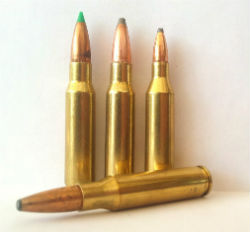 In simplest terms the .243 is a necked down .308 case which can be loaded with bullet weights that range anywhere from 55 grains to 115 grains. The lighter bullets typically being used for vermin and fox with bullets of 90grains and upward being typically used for deer.
In simplest terms the .243 is a necked down .308 case which can be loaded with bullet weights that range anywhere from 55 grains to 115 grains. The lighter bullets typically being used for vermin and fox with bullets of 90grains and upward being typically used for deer.
(Left: Back row in order from left to right, .308 ballistic tip, .308 Soft point, .243 Soft point. The .243 Winchester is simply a necked down .308 case)
In the UK the .243 calibre has gained an excellent reputation which was compounded in 1963 with the Deer Act which required at least a .240 calibre rifle for use on deer. This legislation has meant that in order to be able to shoot all species of deer in the UK the .243 calibre is seen as the entry level calibre for deer stalking.
Producing around 1950 ft lbs of energy at the muzzle with 100 grain bullets the .243 goes on to deliver 1600 ft lbs at 100 yards and around 1350 ft lbs of energy at 200 yards.
The bullet trajectory whilst being inferior to the .308 parent cartridge at longer ranges is in fact flatter shooting than the .308 out to at least 300yards due to its higher velocity. Typical drop for a 100grain bullet with a 100 yard zero is 3.3 inches at 200 yards and 12.5 inches at 300 yards.
For many this is a popular calibre with which to start deer stalking, added to which Home Office Guidelines for the police mean that for the beginner this is considered to be the most acceptable calibre for those first requesting a deer calibre on their Firearm Certificate.
Famously having been used by the LAPD SWAT teams this calibre benefits from mild recoil and muzzle blast and is extremely accurate. It is also very well suited to lighter framed shooters and in countries outside the UK where there are restrictions on the use of military calibres the .243 also fits the bill.
All things considered for deer stalking in the UK the .243 Winchester is a great calibre. Some will argue that it doesn't quite pack enough of a punch for the largest of our Uk deer species however for Roe and Muntjac it is certainly one of the best calibres available.
At County Deer Stalking we use this calibre loaded with 100 grain ammunition in a Sauer 202 as one of our Estate rifles.
Typical .243 Ballistics (100 grain bullet)
Muzzle Energy: 1950 ft/lbs Muzzle Velocity: 2960 fps




